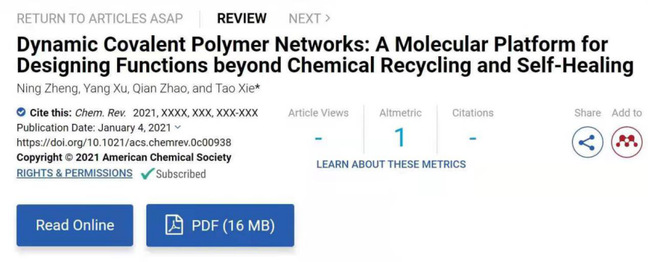


Synthetic polymers (plastics) have been playing an increasingly important role in the marketplace since the early 20th century, and they have been indispensable to industrial development. However, a series of environmental problems caused by plastic products have begun to attract more and more attention with the sustainable social development.
Traditional polymer materials consist of thermoset and thermoplastic materials. Thermoset polymers (e.g. epoxy resin substrates, polyurethane foams.) have better dimensional stability and creep resistance than thermoplastic polymers and are therefore widely favored. However, it is also their chemical cross-linking that prevents thermoset polymers from being recycled and reproduced.
How to dispose of plastic waste and reduce environmental pollution has become a headache.
Is there a material that retains the advantages of thermoset plastics but can be reprocessed and recycled like thermoplastics? Dynamic covalent polymer networks (DCPN) offer a possibility, and they are beginning to challenge our understanding of traditional polymers.
Recently, a paper entitled “Dynamic Covalent Polymer Networks: A Molecular Platform for Designing Functions beyond Chemical Recycling and Self-Healing” was published in Chemical Reviews, a top international review journal, with corresponding author of Prof. XIE Tao and first author Dr. ZHENG Ning from ZJU-Hangzhou Global Scientific and Technological Innovation Center.
Dynamic covalent bonding is a class of chemical bonds that can realize reverse exchange under certain conditions (e.g., light, heat, humidity stimulation). The introduction of dynamic covalent bonds into polymers can form Dynamic Covalent Polymer Networks (DCPN), which have very different properties from traditional thermoplastic and thermoset polymers.
In the last decade, DCPNs have made tremendous progress in new dynamic covalent chemistry, fundamental material concepts and emerging applications. The review focuses on four advances in Chemical Recycling, Self-Healing, Solid-State Plasticity, and Topological Transformation, highlighting the network structure design of functional materials and envisioning how DCPN complements traditional thermoplastic and thermoset polymers and how they shape the future together.
The reuse and recycling of polymers have been under heated discussions nowadays as they play an important role in environmental protection and energy conservation, and DCPNs have attracted much attention for their unique role in chemical recycling and self-healing. The review summarizes the recent progress of DCPN in chemical recycling and self-healing, and provides insight into the nature of these two applications and the reasons why they have not yet been truly applied into industry from technical fields.
In addition, DCPN possesses functional properties that traditional thermoplastic and thermoset polymers do not have. One of the most important properties is solid-state plasticity, i.e., the ability of a material to deform plastically in the solid state, thus changing its permanent shape and giving it new properties. DCPNs with solid-state plasticity have shown marvelous design versatility in deformation devices, artificial muscles, and micro and nano processing.
The topology determines the properties of polymers, which in turn affects their application. The topology of polymers is generally pre-designed and is unchangeable after the material is synthesized to achieve desired properties unless they contain “active centers” that can be further polymerized (e.g., reactive polymerization). In contrast to conventional findings, the topology of polymer networks can be manipulated with dynamic bonding, facilitating easy post-programming of the topology. Since dynamic bonds can be activated repeatedly, proposed in this review is the concept of living network, which deems the DCPNs whose topology can be transformed can be regarded as living networks.
This concept emphasizes the change of network topology after synthesis, including the steady evolution and growth of polymer networks. The review lists three types of topological transitions with different mechanisms: topological transitions with active chain growth, template-induced topological switching, and topological isomerization (Topological Isomerization), summarizing their distinctive features and advantages, and thus validating the concept of active networks.
In conclusion, different from conventional thermoset and thermoplastic polymers, dynamic covalent polymers are a class of polymeric materials with unique properties that are expected to shed new light to human society together with conventional polymers in the future.
The full paper is available at https://pubs.acs.org/doi/10.1021/acs.chemrev.0c00938












